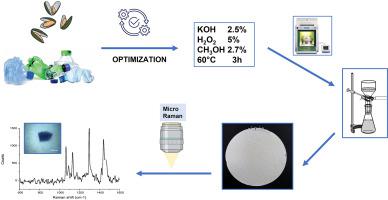Marine Pollution Bulletin ( IF 5.8 ) Pub Date : 2021-09-15 , DOI: 10.1016/j.marpolbul.2021.112931 Silvia Fraissinet 1 , Antonio Pennetta 2 , Sergio Rossi 1 , Giuseppe E De Benedetto 2 , Cosimino Malitesta 1

|
Over the last few years, different digestion protocols have been proposed to extract microplastics from mussels, an important product from aquaculture and a relevant economic resource, always scrutinized as a potential pollutant concentrator. In this study, a full factorial experimental design technique has been employed to achieve efficiency in removing biological materials while maximizing the recoveries of five common microplastics (polyethylene, polystyrene, polyethylene terephthalate, polypropylene and polyamide). A robust setpoint was calculated, 2.5% potassium hydroxide at 60 °C for 3 h with 5% hydrogen peroxide and 2.7% of methanol, permitting the quantitative digestion of mussel tissues and recovery of microplastics. These experimental conditions were successfully used to digest whole mussels bought from a local market, which possess high levels of microplastic contamination (41 items/g dry weight). The results highlight the importance of optimizing protocols to develop robust, easy to use and cheap quantitative approaches for analysing microplastic accumulation in edible organisms.
中文翻译:

微塑料分析中用于定量贻贝消化的新多试剂程序的优化
在过去的几年里,已经提出了不同的消化方案来从贻贝中提取微塑料,贻贝是水产养殖的重要产品和相关的经济资源,一直被视为潜在的污染物浓缩器。在这项研究中,采用了全因子实验设计技术来实现去除生物材料的效率,同时最大限度地提高五种常见微塑料(聚乙烯、聚苯乙烯、聚对苯二甲酸乙二醇酯、聚丙烯和聚酰胺)的回收率。计算了一个稳健的设定点,2.5% 氢氧化钾在 60 °C 下与 5% 过氧化氢和 2.7% 甲醇混合 3 小时,允许对贻贝组织进行定量消化并回收微塑料。这些实验条件成功地用于消化从当地市场购买的整个贻贝,具有高水平的微塑料污染(41 件/克干重)。结果强调了优化协议以开发强大、易于使用和廉价的定量方法来分析可食用生物中微塑料积累的重要性。



























 京公网安备 11010802027423号
京公网安备 11010802027423号